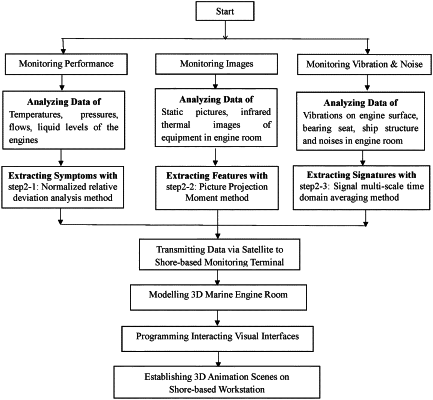| CPC G06T 19/006 (2013.01) [G06V 20/52 (2022.01); H04L 67/12 (2013.01); G06F 2218/08 (2023.01); G06T 2200/08 (2013.01)] | 1 Claim |

|
1. A remote monitoring method based on information fusion and virtual reality for a marine engine room, comprising the following steps:
step1: employing temperature sensors, pressure sensors and level sensors to collect thermodynamic parameters; employing engine room cameras, infrared thermal imagers to collect marine engine room images; employing acceleration sensors to collect vibration & noise signals; transferring data of the above sensors' data by means of a data acquisition card to a host computer; connecting signal lines between the host computer and the data acquisition card; connecting signal lines between the data acquisition card and the sensors; connecting signal lines between the engine room cameras and infrared thermal imagers to the host computer; supplying power supply via a power source to the host computer, the data acquisition card, the engine room cameras and the infrared thermal imagers; and then turning on a power source;
step2-1: using normalized relative deviation analysis method to obtain symptoms of the thermodynamic parameters including temperatures, pressures, flows, liquid levels of the engine;
the specific process of the normalized relative deviation analysis method is as follows: for a thermodynamic parameter x alternatively representing temperature, pressure, running speed, flow or liquid level of the engine; setting the thermodynamic parameter x to its normal scale x0 under normal condition as ε=(x−x0)/x0, wherein x and x0 being the thermodynamic parameters of the diesel engine under failure and normal conditions, respectively; normalizing relative deviation to a reference condition of 286° K engine room temperature according to actual engine room temperature t ° K, wherein ε′=(t−286)×ε/114; normalizing thermodynamic parameter as x′=x/(1+ε′);
step2-2: using multi-scale time domain averaging method to extract signatures of vibration & noise signals on engine surface, bearing seat, ship structure and noises in the engine room; the specific process of the multi-scale time domain averaging method is as follows: setting a vibration signal z(t) of marine rotating machinery to contain multiple periodic signals y(t), z(t)=y(t)+e(t), y(t) being a signal composed of r different periodic signals, and e(t) being an error parameter; under condition of constant speed, a number of samples between any two punctuations being a fixed value M, with M being the size of a sub-signal array; dividing z(t) into p segments to obtain a sampling signal of vibration signal as
 step2-3: using projection moment method to describe dynamic characteristics of static pictures, infrared thermal images of multiple pieces of equipment in the engine room; the specific process of the projection moment method is as follows: superimposing several infrared thermograms in sliding time window on a projection plane; saving the extracted features of image color, size and location in the host computer;
step3: extracting features in the performance parameters, infrared thermal images of the multiple pieces of equipment in the engine room as water inflow, engine room firing, pirate invasion, electrical short circuit; applying transient impact signal, instantaneous speed, multi-scale time domain averaging and fuzzy entropy feature extraction methods to extract signal waveforms in multiple periods, retaining fault features at all frequencies, and removing redundant information in a 3D display workstation;
step4: transmitting the analyzed results of the performance symptoms, extracted features of the images and vibration signatures to a shore-based monitoring terminal as follows: processing network messages based on select multiplexing, compiling network manager, which at least includes the following functions of: sticky packet subcontracting, data sending, heartbeat mechanism and event distribution; carrying out data communication based on TCP network protocol with Socket to realize the network communication;
step5: establishing visual 3D scenes of the marine engine room based on the performance parameters including temperatures, pressures, running speeds, flows, liquid levels of the systems and the characteristic features of the static pictures, infrared thermal images, vibration & noise signatures; in combination with pre-established 3D models of the marine engine room, interacting the 3D scenes with operators and displaying a real scene of the engine room through the visual interfaces.
|